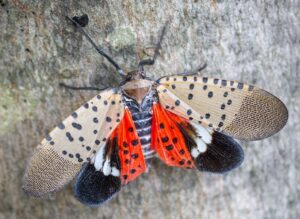Invasive Spotted Lanternfly Impacts on Native Forest Trees
A newly invasive insect pest known as the spotted lanternfly (Lycorma delicatula) poses an important, emerging threat to forest habitats. The spotted lanternfly (SLF) is a planthopper (order Hemiptera, family Fulgoridae) native to northern China but was recorded for the first time in the Americas in Berks County, southeastern Pennsylvania in 2014, suggesting a recent human-mediated introduction. Since then, it has spread across much of southern and eastern Pennsylvania and to neighboring states.
The SLF is of particular concern as it has the potential to cause harm to a wide variety of tree, shrub and vine species. Both nymphs and adults feed on phloem in leaves and stems, damaging plants by extracting energy-rich sap and causing oozing wounds, leaf wilting, death of branches, and sooty mold build-up, and by increasing susceptibility to plant pathogens. This damage can result in mortality of the plant. Should SLFs continue to spread, costs of these damages to commercial interests in agriculture and forestry may reach up to $100 million annually within Pennsylvania and billions annually nationwide. The SLF invasion further has the potential to reshape forest communities and threaten ecologically important plant species.
Because the specific effects of SLFs on forest trees have yet to be studied extensively, much remains unknown. Potential negative outcomes of the SLF invasion include reduced tree health, increased tree mortality, reduced resilience of forest communities to disturbance, and potential degradation of forest habitat quality for plant and animal species of conservation concern. The invasion may become increasingly problematic as SLFs continue to spread and increase in abundance over time.
Past research indicates SLFs prefer an invasive host tree known as the tree of heaven (Ailanthus altissima), though SLFs do not depend on this species to complete their life cycle. Further, SLFs have been recorded feeding on more than 70 plant species in Asia and already more than 30 thus far in North America. Feeding does not necessarily equate to impact, however, and it remains unclear which trees and herbaceous plants are most susceptible to damage and mortality from SLF feeding. Further, there is often a time lag between the initial SLF invasion in a locality and the period of explosive population growth there. Thus, some threats to forest trees and other plants may only become apparent at later stages of the invasion, as the local SLF population attains high densities. In this study, we are assessing the nature and extent of threats that SLF poses to forest trees and herbaceous plants, including physiological impacts that may be more difficult to detect.
In collaboration with Dr. Brent Sewall and a team of faculty, technicians, and students, we conduct SLF research at the Temple Ambler Field Station. Our field activities include surveys, trapping, and the maintenance of a large mesocosm experiment to assess the impact of SLF densities on native plants.

Spotted lanternfly mesocosm array at the Temple Ambler Field Station.
